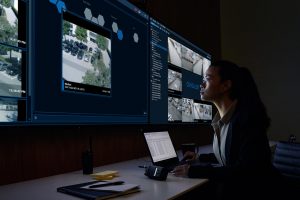Video surveillance can make your transportation operation safer.
Contact Us to learn more.
Transportation operations across Alberta run on tight schedules. Anything that gets in the way of drivers meeting or beating the goal of arriving on time can have a host of consequences. They can range from an unpleasant rider experience to serious downtime on a job site if personnel fail to show up on schedule. Picture would-be passengers waiting on an Edmonton LRT platform. Imagine a foreman near Fort McMurray, unable to get the job started because the fresh rotation of workers hasn’t arrived at the mine site. The frustration and potential for downtime are both very real.
Plenty of factors can contribute to delays, and safety is at the top of the list. That’s why so many public and private transportation operations use video surveillance systems. They can be a major asset in mitigating or preventing risks to safety, especially when paired with video analytics tools from providers like Avigilon.
If you’d like to discuss your needs and objectives with someone, feel free to Contact Us. In the meantime, keep reading to see a few of the ways video surveillance systems and video analytics can keep transportation operations safe and on schedule.
They Help Tackle the Problem of Overcrowding
If you’ve ever been on the bus or LRT in Edmonton or Calgary, especially during rush hour or game day, you know it can get packed. While a crowded bus or train may not delay the driver all that much, it certainly delays the would-be passenger who has to wait anywhere from five minutes to half an hour for the next bus or train to come by.
Drivers do their best to keep track of how many passengers they transport and, sometimes, public transit authorities send staff members out to do a headcount. But both methods carry with them an element of human error.
CCTV cameras can eliminate these errors. They give transit authorities an accurate record of how many people are riding at any given time, on any given day. With that information, managers can add buses to routes or add additional cars to the LRT, so overcrowding isn’t an issue.
On the other hand, if certain routes or times of day have lower ridership, managers can reduce the costs of the transit system by deploying fewer vehicles. That means using less fuel, reducing wear and tear on the fleet, and only scheduling drivers when the volume of riders requires it.
Investigation and Deterrence
Simply put, CCTV cameras let people know they are being monitored, and that alone can be enough to deter reckless or dangerous behavior.
However, if an incident does occur, CCTV systems will capture the evidence investigators rely on. HD CCTV can provide investigators with crystal-clear footage and images, making the job of identifying and locating persons of interest that much easier.
Today, Tridon is working with Avigilon to provide video surveillance solutions to a range of industries, including transportation. In addition to providing high definition video and still frames, Avigilon video surveillance systems are equipped with video analytics that can make monitoring live feeds and investigating incidents an incredibly efficient process.
You can Contact Us to learn more, or just keep reading.
Avigilon’s Video Analytics and How They Help
A CCTV system can easily have dozens, if not hundreds, of cameras operating at the same time. In older systems, live feeds from those cameras have to be continuously monitored so that nothing is missed. If there is an incident, security personnel may have to watch hours of footage from multiple cameras during their investigations.
Avigilon’s video analytics dramatically reduce this by providing a number of search tools. They help security personnel respond to incidents well before they escalate and investigate incidents far more efficiently.
Here are a few of those search tools, and how they can be applied to the transportation industry.
Classified Object Motion Detection Protects Your Drivers
Cameras equipped with Classified Object Motion Detection begin recording when a person or vehicle enters a enters the camera’s proximity (a distance you can customize for your needs). This feature is also capable of differentiating between men, women, and children based on characteristics like height.
Now, picture a city bus or charter bus. Most buses have lines painted on the floor that passengers need to stay behind once they board. If a passenger ever got too close to the line or crossed it, a CCTV camera programmed with Classified Object Motion Detection would begin recording. If the driver was using a Motorola two-way radio, the camera could even send an alert to the radio, informing him that a passenger was too close.
This can be a useful tool if a driver has to remind passengers to obey the safety rules. It can also be used to warn drivers if a passenger is approaching in a threatening manner. If the bus is equipped with a drier enclosure (as many are in Edmonton), drivers can seal themselves in and radio for help.
Unusual Motion Detection Keeps the Routes Clear
As the name states, cameras programmed with this feature detect and record any activity that they deem to be out of the ordinary. There are many ways this can be helpful in the transportation industry, most notably in public transit applications.
A person falling on the tracks of the Edmonton LRT system or running across the tracks while the guard rails are down, are two types of activity that would be deemed ‘unusual’. If either were to occur, cameras programmed with this feature could send an alert to train operators and security personnel. They, in turn, could respond appropriately by safely slowing to a stop and providing assistance, respectively.
‘Unusual motion’ also includes people and vehicles idling for extended periods of time. So, if a vehicle were to break down at a rail crossing, or simply stop to close to the guard rails as a train approached, cameras programmed with Unusual Motion Detection would detect that, as well, and alert security personnel and train operators so that they could respond appropriately.
Appearance Search Identifies Persons of Interest
As we mentioned before, incidents can occur in the transportation industry, both in public transit and private charter. When they do, having a way to easily find that person is immensely valuable.
Appearance Search allows security staff to look for individuals based on characteristics like height, gender, hair color, clothing color and so on. If somebody is involved in an incident, Appearance Search helps security staff locate them, even if they change buses, trains or get off at a stop.
And, because of the high definition capabilities of modern CCTV cameras, security staff can easily obtain a clear photo of the person for future use. If a person responsible for an incident goes to an LRT platform or gets on a bus, an alert will be sent to security personnel.
The same can be said for chartered bus lines. If a customer has caused problems in the past, either by being disruptive, hostile or even violent, CCTV cameras installed on the bus could capture a clear record of the incident. With high-quality images of the person or people involved, bus companies could take steps to protect passengers and drivers on future journeys.
The information could be provided to police if the matter warranted, and the CCTV system could even alert a bus company’s security staff if that person boarded again, or simply entered one of their bus stations.
Getting Started
It’s hard to overstate the safety and security benefits video surveillance systems provide to transportation operations. And, while many of our examples focused on public transit, the benefits can be realized by charter bus lines, school bus operators, or any other company in the business of getting people from A to B on a tight schedule.
If you’re curious about how you can make video surveillance a part of your fleet, Contact Us. Our Account Managers and Service Technicians can answer any of your questions. We’re here to help.
Tridon is a full solution Telecom Systems Integrator with CSA certification and licensed by APEGA. Our Engineering, Service and Tower Divisions collaborate with customers to build engineered solutions including communications systems design, tower inspections, and co-location, wireless broadband, fiber optic cabling, site security, and two-way radio communication.





